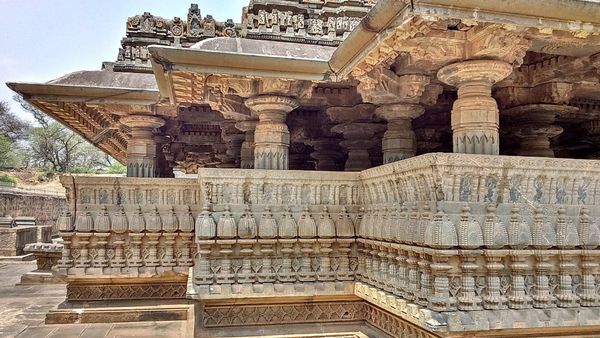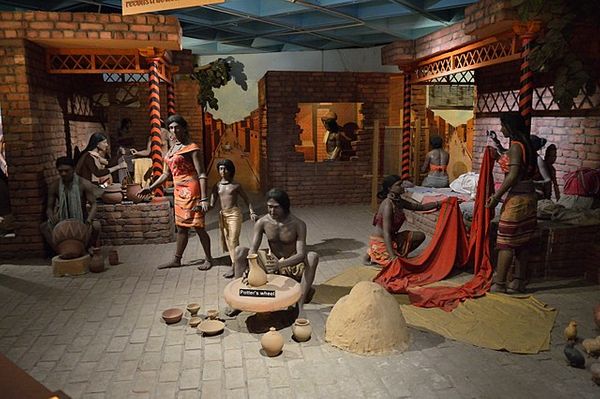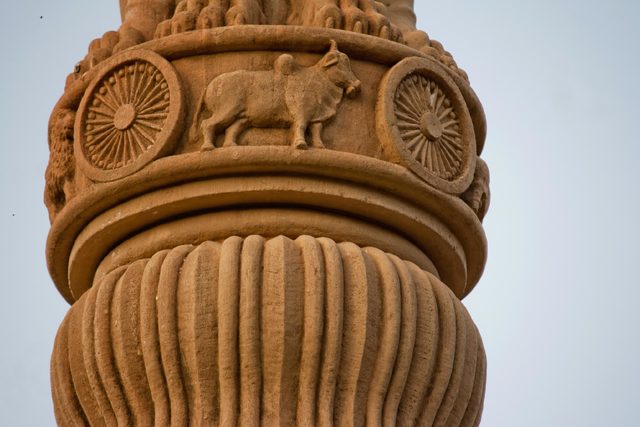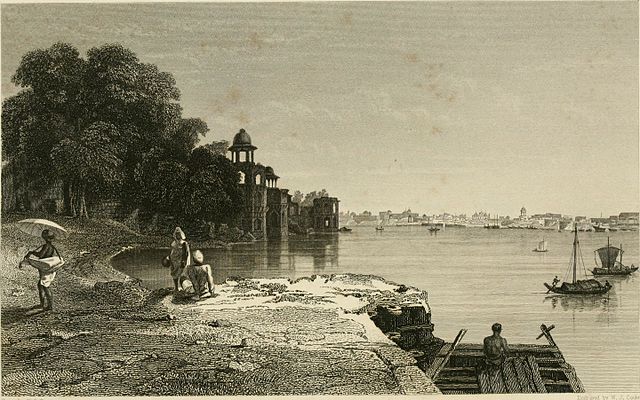India is one of the few countries in the world that has two official names. The article 1 and clause 1 of the Indian Constitution states, “India, that is Bharat, will be a Union of States.” India is the name that the Western World gave us and by which the whole world knows us today. But Bharat is the name that we gave to our own country.

Did You Ever wonder why we call our Nation Bharatiya Ganarajya? What does Bharat mean? From where did the word originate?
A
prelude to the beginning
India was not created artificially like Pakistan in 1947 and it was not a ‘New Nation’ but a continuation of an ancient civilization which in the 1st century BC stretched the whole length and breadth of entire South Asia and whose influence stretched far to the outer edges of Asia and beyond.
The origins of the civilization lie in the Harappan civilization that existed around 4000 BC in the North-Western Part of the subcontinent. The Harappans were the contemporaries of the ancient Egyptian, Chinese and Mesopotamian civilizations. The heartlands of the Harappan civilization stretched from Gujarat in the south, across Sindh and Rajasthan and continuing into Punjab and Haryana. Many other sites of their civilization have been found out of this core area, some as far east as Uttar Pradesh and as far west as Sutkagen-dor in Baluchistan near Iran.
There is one site in central Asia called Shortughai along the Amu-Darya river near the Afghan-Tajik Border. The sheer geographical spread, the number of sites and the implied population of the Harappan Civilization is far larger than that of the Chinese, Egyptian and Mesopotamian Civilizations of that time. There is no clear evidence as to what happened to the Harappan people after a period of severe decline, but modern archaeological evidence suggests they slowly drifted east and south and mingled with other group of people in the Indian subcontinent and influenced their culture and to some extend may have subtly shaped the Indian civilization.

Indus Valley Diorama – Indian Science and Technology Heritage Gallery – National Science Centre – New Delhi. Pic Credits: Biswarup Ganguly [CC BY 3.0 (https://creativecommons.org/licenses/by/3.0)] via Wikimedia Commons
There are many traits of the Harappan civilization that we can see even in present day India, like the common greeting ‘namaste’, use of bullock carts, practice of putting vermilion or ‘sindur’ on the forhead. There is indeed a possibility of continuity from the harappan civilization to the Rig Veda period.
Origins
Rig Veda was written during the Bronze age and it mentions the ‘Battle of Ten Kings’ that was fought on the banks of river Ravi in Present day Punjab. The Rig Veda talks about how ten powerful tribes amassed their forces against one tribe, the tribe of the Bharatas. In the ensuing battle, the Bharatas routed the combined forces of the ten tribes. Thereafter the Bharatas became the preponderant power in the subcontinent. Their control of the cultural heartland magnified their influence in the whole subcontinent.
The Bharatas, who had great influence and prestige in the region, must have patronized the writers of Vedas as the Vedas, specially the Rig veda, are full of praises for the Bharatas but they also praised the sages and persons from other tribes. Even sages from the tribes that were rivals of the Bharatas found their place in the Vedas. There lies the true greatness of the Bharatas, they through civilizational assimilation and accommodation created a unique civilization, that with time our ancient forefathers from all over the subcontinent started associating with and considered themselves to be a part of Bharat Varsha. Bharat Varsha was not a political term. It did not mean a political entity, as the region known as Bharat Varsha was not under one political authority.
Bharat Varsha for the people of ancient India meant an entire civilization, whose area stretched from the Hindu Kush in the west to the swamps and forests of Bengal and Assam in the east and from the Himalayas in the north to the serene beaches of Kerala in the south.
The great King of the Bharatas, Sudasa performed the Ashvamedha ritual or Horse Sacrifice and was declared a Chakravartin or the Universal Monarch. The word ‘chakravarti’ means ‘wheels that can travel anywhere’, implying the Monarch’s chariot can roll in any direction. Thus, wheel became an imperial symbol in the consciousness of the people, that over the centuries would be used by imperial powers such as the Mauryans. The wheel remained a powerful imperial and spiritual symbol in the Indian consciousness and found its way into the Indian National Tricolour. Thus, the ancient symbol of wheel still adorns the flag of India or Bharat.

BHARAT – AN ‘IMPERIAL DREAM’
The success of the Bharatas and their King Sudasa might have planted the seeds of an Imperial dream. A dream to rule over the whole of the Civilization, to politically unite the Bharat Varsha and to become the Samrat or Emperor of Bharat. Perhaps it was with this dream in his mind that Chanakya, the great intellectual of the ancient world and a Professor of Political Economy at the Taxila University, guided Chandragupta Maurya and helped him in establishing the Mauryan Empire, an empire that would eventually conquer almost the whole of the subcontinent.
At its height, the Mauryan Empire was the largest and most populous empire in the world, dwarfing both Alexander’s Empire and Shi Huangdi’s empire in China.
OF
PILLARS, LIONS AND THE WHEEL.
The Mauryans, specially under Emperor Ashoka the Great, erected many Imperial Pillars and Edicts. These Pillars were adorned by the images of Lions and Wheels. The Lion, a symbol of Imperial power and the Wheel, a symbol of the ‘Universal Monarch’. These pillars have been found throughout the Indian subcontinent from Afghanistan in the north to Karnataka in the south and from Gujarat in the west to Bengal in the east. These pillars and edicts can give a rough idea about the territorial extent of not only the Mauryan Empire but also the Bharat Varsha.
No doubt the pillars were erected to impress the subjects and showcase the strength of the Mauryans but perhaps Ashoka also intended to be remembered long after he is gone as a Samrat who ruled over the whole of Indian civilization. Ashoka is still remembered today and his Symbol of Lion and Wheel were incorporated into the Indian Emblem and Tricolour. The later rulers of the subcontinent were awed by these pillars and could sense an ancient Imperial power talking to them through these pillars.

Photograph of the Lion Capital at Sarnath, Uttar Pradesh. Pic Credits: Madho Prasad, c.1905 . [Public domain], via Wikimedia Commons
They understood that they were the inheritors of an ancient Imperial dream and chose to augment their position and leave their mark in this ancient land through their own pillars and columns. That is why the emperors of the Gupta and Mughal dynasties, went out of their way to put their own inscriptions next to those of Ashoka. The founding fathers of our nation understood that the lion and the wheel stand for the power of the state and as such they incorporated them in our national Emblem and Symbols.
TOLERANCE
AND CIVILIZATIONAL ACCOMODATION.
The inclusive and tolerant nature of the Bharatas, who had created a unique template of civilizational accommodation and tolerance, remained stuck with the civilization that they had nurtured, even long after they have vanished from the face of the earth. Civilizational accommodation, tolerance and assimilation became the inherent features of our civilization.
Throughout our History at different times people from outside of India came, settled down and flourished. Be it the Muslim Mappila community whose ancestors came from Arabia and married local women, or the Ahoms; who came from Burma, got assimilated and Indianized and founded their own Kingdom, they all flourished and were accepted and absorbed into the Indian civilization. The case of Parsis, who came to India from Iran as refugees, is one more example of Bharat’s inclusive and accommodating nature.
Even the Mughals, who were of central Asian Mongol ethnicity and had conquered large parts of India, found themselves slowly being assimilated, accepted and absorbed by a superior civilized culture and have since become a part of Indian heritage.

Bharat has always been a land of multiple religions, cultures and languages and it is this inherent quality of tolerance and accommodation that has made Indian Civilization, perhaps, the oldest continuing civilization in the world.
SPIRITUAL
INCLINATIONS
Spirituality and not religion dogmatism are an essential feature of our civilization and our history is filled with great examples of sages, kings, emperors who gave up material wealth for the spiritual. Chandragupta Maurya, the founder of the Mauryan Empire, placed his son at the throne and became a Jain monk, giving up material possessions. He walked naked into the wilderness, giving up all worldly possessions and spent the last days of his life meditating on a hill and fasting to cleanse his soul. Such example of Emperor giving up material wealth and living off his last days as a poor monk is extremely rare.
Akbar the Great, the legendary Mughal emperor, was known for his secular attributes. He used to hold spiritual discussions and debates among various religious men, mostly Hindus and Muslims in his Ibadat khana. He had further founded a new religion called Din-i-Ilahi, which was a unique blend of Hinduism and Islam. These examples show that not only the saints but even the emperors had spiritual awareness. The practice of renunciation of worldly comforts or power is greatly respected in India.
Gandhi’s renunciation of power after India became an independent nation and letting Nehru become the Prime Minister was greatly hailed as a saintly action. This spiritual awareness and respect for different religions and in particular respect for the great acts of sacrifice and renunciation have been greatly appreciated in India and it has many a times shaped our history and politics.
CONCLUSION
India that is Bharat is not just a union of states but a union of people who share a strong civilizational unity. Bharat is but a continuation of an ancient civilization. In 1947 the ‘imperial dream’ of our forefathers was fulfilled and Bharat Varsha came under one Political authority. Strangely the imperial dream was not achieved by any Samrat or Emperor but by the people of this country as a republic.
The Europeans, who share a common Greco-Roman civilizational unity, is facing a similar situation and the idea of Europe is slowly inching towards fruition through a supra-national organization, that is European Union. Unlike the Europeans, even after politically uniting Bharat Varsha, we are not conscious about our civilization origins, heritage and character. We are more concerned about religious, linguistic and caste chauvinism. The day we, as a society, become intolerant, unaccommodating and dogmatic we will cease to remain the inheritors of this great civilization of ours.
The idea of Bharat lies in the awareness that we all, in spite of different linguistic, cultural and religious backgrounds, share the same civilizational origins and character; and the land of Bharat is not a land divided by states but an ancient land united and molded by our common civilizational heritage. This is the Idea of ‘ Bharat ’ that we should keep in mind. Jai Hind.

